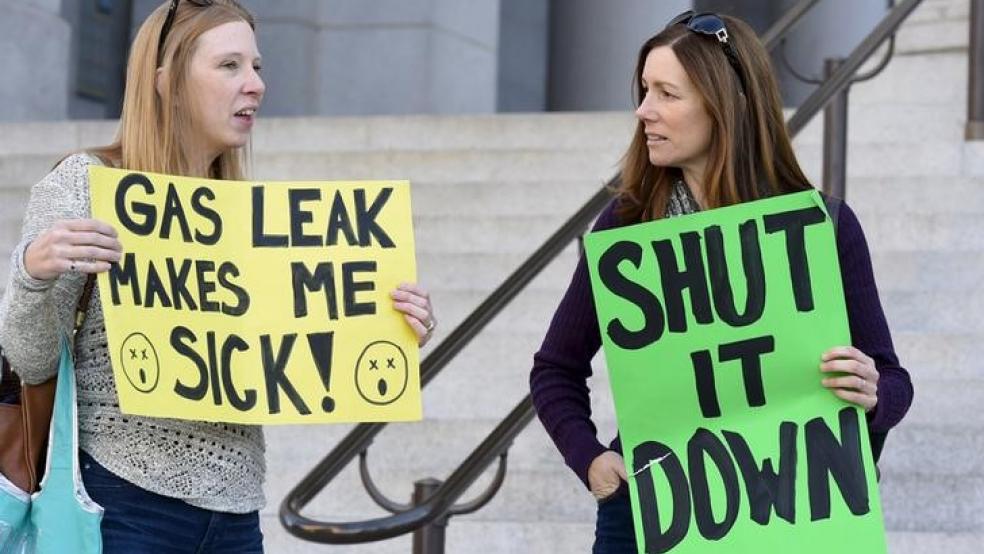If you drive down Porter Ranch Boulevard — past the banal shopping center with a Petco and a JoAnn Fabrics, up into the brown hills, across the subdivision with identical clay tile roofs — you would have little sense of why this Los Angeles suburb has made national news.
There isn’t a lot of foot traffic, but that’s a function of being a southern California bedroom community with no town square where everyone has to drive to reach anything. But the library and the YMCA are packed. Traffic flows robustly along the avenues. I even saw a few people out walking their dogs on the mostly unused hiking trails.
The smell kind of sneaks up on you, kind of like if you stand too long outside a Shell station. It’s not particularly pungent, or at least wasn’t on the windy day I visited. But after about an hour or so in Porter Ranch, I did feel a slight headache coming on.
Related: Why the Gas Leak in California No One Is Talking About Is Such a Disaster
Despite Gov. Jerry Brown issuing a state of emergency for Porter Ranch due to
the massive Aliso Canyon gas leak, which has been ongoing since October with no end in sight, life mostly goes on. And this actually upends some long-held assumptions about environmental justice, particularly the idea corporate polluters only prey on the weakest, most vulnerable communities. If a wealthy Los Angeles suburb like Porter Ranch cannot rouse action, there’s little hope for the rest of us.
The town’s tragedy reflects a combination of corporate brazenness and regulatory incompetence. The Aliso Canyon gas storage facility, a converted oil field and one of the largest storage locations in North America, sits in the Santa Susana mountains above Porter Ranch, similar to other areas of California where fossil fuel production intermingles with residential neighborhoods. Some 5.4 million state residents live within one mile of an oil or gas well.
The community has always been perilously perched; an oil and gas well caught fire in 1968, around the time of the first developments, and other fires periodically break out and threaten homes. The gas leak represents an additional threat.
Related: LA-area Residents Implore Officials to Approve Plan to Mitigate Gas Leak
On Oct. 23, officials with SoCal Gas discovered a well leak more than 8,000 feet underground, where the pipeline meets the capstone of a natural gas reservoir. The disaster is similar in scope to the Deepwater Horizon leak in the Gulf of Mexico. In this case, nearly a quarter of the state’s total release of methane gas — among the most harmful greenhouse gas emissions — is flowing from the leak. According to the California Air Resources Board, it has emitted the equivalent of the annual pollution from over 480,000 cars, and it isn’t close to being contained.
SoCal Gas, after six failed attempts to stop the leak, is drilling two relief wells to cut off the gas. But they’ve only made it halfway down to the source thus far.
The near-term public health risk comes from the mixing of the methane with “odorants,” chemicals that provide a warning for leaks deep underground. These odorants have sickened residents with headaches, vomiting and asthma. Over 2,000 families have left their homes, at SoCal Gas’ expense, moving into hotels or temporary housing. Two schools in the community have been closed. I didn’t see anyone walking around with surgical masks, but that has been reported. I did see several signs warning of vigilance against crime, as empty, affluent homes make for attractive burglary targets.
Regulators describe the Aliso Canyon facility as gleaming on the outside but junk beneath the surface. Incredibly, when the leaking well was last upgraded — all the way back in 1979 — officials removed a safety valve that would have prevented the disaster. Even more incredibly, that valve was not required under state or federal rules; only wells within 300 feet of a home must have them. SoCal Gas apparently lied to regulators about replacing the valve.
Related: Did a Bad Decision 40 Years Ago Lead to the California Gas Leak Disaster?
Briana Mordick of the Natural Resources Defense Council cites flawed state regulation of underground oil and gas wells as a major culprit here. The state Underground Injection Control program suffers from inadequate staffing and a lack of testing (pressure tests only occur every five years, for example). The program also allows corroding wells like the one leaking, which was built in 1953 as an oil well and converted to gas storage in 1973, to remain in use despite outdated construction. Like the missing safety valve, state regulations do not required older wells to be retired. “In fact, California's UIC rules don't include any standards for well construction,” Mordick writes.
Critics have implicated Jerry Brown in this leniency, citing his industry ties. He has resisted tougher regulations on fracking. He has explored for oil and gas on his own private land. Brown’s sister, Kathleen Brown, is a board member with Sempra Energy, the parent company of SoCal Gas.
A common trope is that communities like this get much more attention from lawmakers than, say, New Orleans after Hurricane Katrina. But Brown waited months to declare a state of emergency. And residents have complained of a lack of outreach about the health risks or their options, to say nothing of their plummeting property values.
I see this as part of the “Bowling Alone” effect. When you have a community of gated developments with no town square, that social dislocation makes it hard to organize. Porter Ranch has never known a day without SoCal Gas lurking over them in the mountains; residents were conditioned to believe it represented no threat to their safety. And their relative power and influence did not protect them from danger.
Related: The Toxic Gas Leak That Can’t Be Stopped Is a Huge Warning Sign
The months of inaction have led to a community response. Groups like Save Porter Ranch are gathering steam. Residents at a meeting of the state Air Quality Management District last week demanded that SoCal Gas shut down its operations in Aliso Canyon, which continue despite the leak. Local lawsuits have mirrored the Los Angeles City Attorney’s case against the gas company. The local neighborhood council and other entities are pressuring authorities for relief and stronger safety measures.
While state lawmakers have made some noise about closing older wells, and while SoCal gas has reduced pressure in the underground reservoir to limit the leak (though this has led to an oily mist surfacing), a visit to Porter Ranch reveals little sign of urgency. The company denies any catastrophe and plans to get things under control by March. And residents, while disheartened, have learned to live with the delay and the imposition on their lives.
The lesson of Porter Ranch is that we have desiccated the public square so much that communities — even ones stocked with upper middle-class people — are more helpless against corporate prerogatives and regulatory sloth than they realize. Disruptions like this can rebuild community, and allow them to fight back. But until then, people can walk around places like Porter Ranch and not even know what risks lurk from above.






